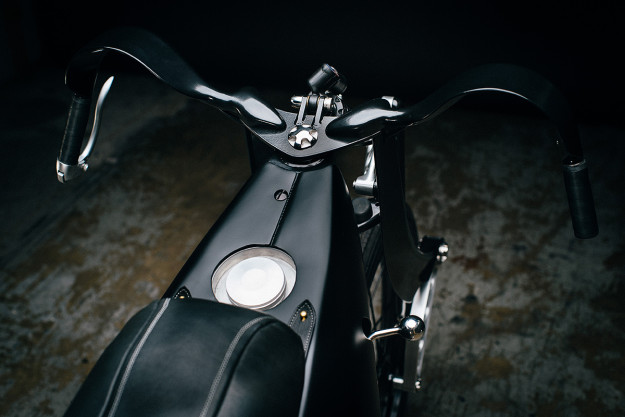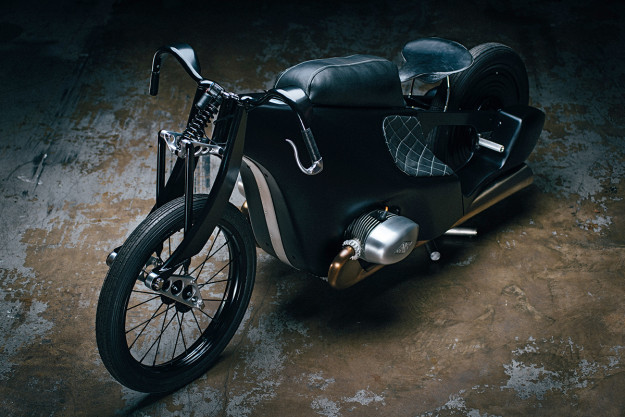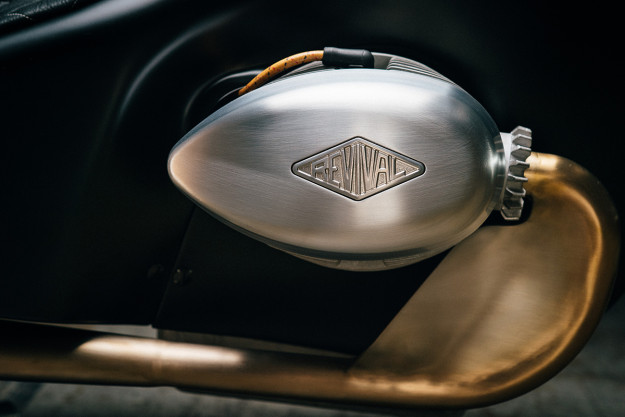
Every once in a while—maybe twice a year—we get to see a build that doesn’t just break the mold, but smashes it to smithereens. This is one such bike, an incredible hand-made BMW from Revival Cycles of Austin, Texas.
The story is just as unusual as the bike itself. “A year ago, a client asked if we would create a custom to display in a gallery he was building for 20 motorcycles,” says Revival’s Alan Stulberg.

“His intention was to hire at least five custom builders simultaneously. All we really knew was that Max Hazan was building one, and we were building one. Of course, we were interested!”
Alan was given full creative freedom, subject to budget. “Not the first time that’s happened, but it was the first time we knew a motorcycle would never be ridden by its owner—and did not need to be street legal.”

After dwelling on the many possibilities, Stulberg chose to build a bike inspired by the extraordinary Ernst Henne Landspeeder. (If you were lucky enough to visit the Wheels & Waves festival two years ago in Biarritz, you’d have seen it there.)
That machine was a 1928 BMW R37 racer—one of the most successful record-breaking motorcycles ever built, and a sight to behold. Stulberg remembers being smitten. “From the aero-shaped handlebars to the solid wheel cover, it was everything beautiful about a race bike that you could imagine.”

Unfortunately, one of Revival Cycles‘ founding principles is that they don’t build sculptures. “We build motorcycles that try to be better than their factory starting points: lighter, faster, better handling and more beautiful.”
Unease spread throughout the workshop. “There was a revolt within the team when I presented this project,” Stulberg recalls drily. He staved it off by deciding to build two machines: the design exercise to sit in his gallery, and a ‘real’ race bike based on the same platform.

The bike we’re looking at here is the gallery bike. But the underpinnings are designed to perform at speed. “We want ‘our’ machine to exceed 150mph, so both builds need to be capable.”
“We also decided that we’d use a more modern version of the engine Henne employed—the liter-size airhead that BMW put in the R100/7.”

Even though the gallery bike will never be ridden by anyone except the Revival team, the engine has been rebuilt. It’s hooked up to a magneto ignition system with electronic advance control—since you don’t need a battery, lights or alternator for race or display bikes.
Revival’s head engineer Stefan Hertel examined Alan’s photos of the Henne bike at Wheels & Waves, and built a CAD model. He’s lengthened the wheelbase just a bit for increased high-speed stability, and dropped the engine in the frame for a lower center of gravity.

The biggest departure is the frame itself: it’s built out of flat-cut steel, instead of tubing. “In land speed racing we know weight isn’t much of a factor for top speed, so strength and beauty ended up being the top priorities.”
“As a team we’ve done quite a bit of work on a Zundapp K800 that had a beautiful stamped steel box frame, so we chose that direction.”

The front suspension is far superior to the one Henne used on his bike, which topped out at 173 mph. The steering angle is a steep 24 degrees, but it’s balanced out with a full six inches of trail. “We did this to further test our theory that steeper rake angles handle better even at high speed.”
It’s a modern interpretation of a classic trailing link suspension, but with a kinematic progressive linkage. A five-way adjustable mono shock allows for changes to preload, high- and low-speed compression, and high- and low-speed rebound.

“This isn’t your standard 80-year-old trailing suspension. It’s lightweight, has very low stiction, a virtually constant trail, low unsprung mass and minimal projected area.”
“We then devised a smooth-as-silk hand shifter,” says Alan. “It rides on sealed bearing axles and feels tighter than a drum, for a solid shift. We also laced up custom wheels with straight spokes for the front, since a brake would not be installed.”

Stefan has also machined up custom stainless hardware, plus the tooling to hold the bike together. There’s an internal throttle for a clean look, and a period-correct reverse-pull clutch cable.
From there it was mostly a stylistic exercise. Machined aero-style valve covers give the profile a smoother look; Revival are considering selling them, but at a price. “They took many hours to get right.”

The next month was spent on the all-alloy bodywork and fairing. “At first we were going to hammer the alloy rough, and a bit ugly like the original Henne bike. But Andy got carried away, and made smooth and flowing lines that are far better than a racing bike would ever require.”
There’s sound to match the looks. With the velocity stack sucking air through the side of the bike, we’re told it “sounds like a monster.” The exhaust system is stainless steel, with air-foiled headers—and the browned exhaust is a reminder that this piece of sculpture runs.

A multitude of hand-fabricated parts were tooled up next. The seat, that oddball belly ‘pillow,’ the grips and the knee protectors are all made from rough-finish leather.
If you want to see the Revival Landspeeder in the metal, you’ve got just one chance: its only public appearance will in April, at the Handbuilt Motorcycle Show in Austin, Texas. (Fittingly, BMW Motorrad supports this year’s show.)

The Revival team is still a little conflicted about building a ‘show’ bike that will only sit under the lights and look pretty. But we think they’re being a bit harsh on themselves. And they’ve already started building the frame for the ‘race’ version.
The geometry, suspension and wheel sizes will be the same, but the engine will be supercharged…

Ernst Henne, the inspiration for this mechanical magnificence, passed away in 2005 at 101 years old.
That’s a ripe old age, but it’s a shame he didn’t live a little longer. We think he’d heartily approve of Revival’s amazing homage to his work.
Revival Cycles website | Facebook | Instagram
